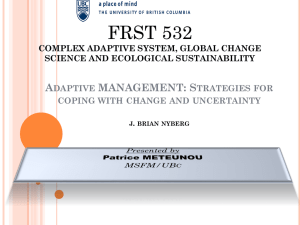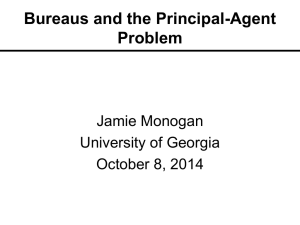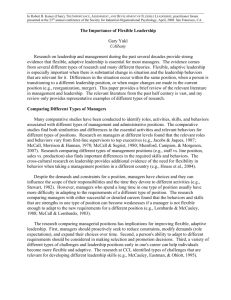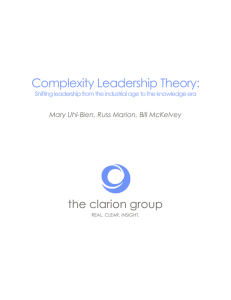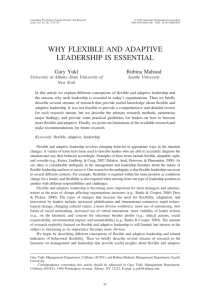Leading to an Adaptive Culture
advertisement
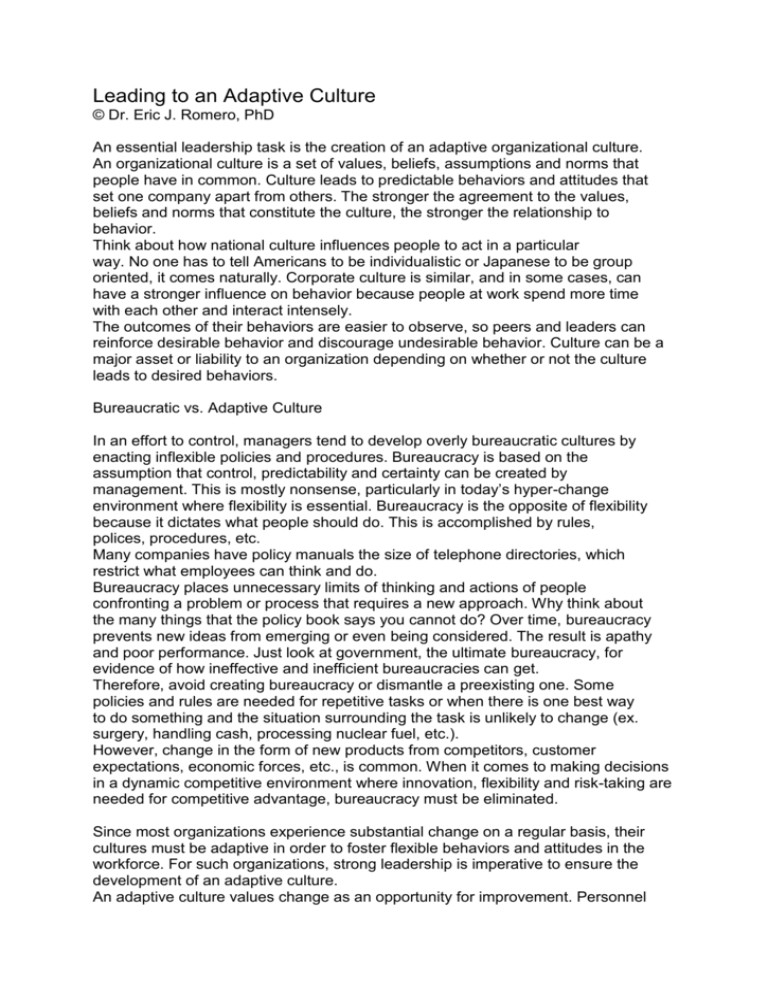
Leading to an Adaptive Culture © Dr. Eric J. Romero, PhD An essential leadership task is the creation of an adaptive organizational culture. An organizational culture is a set of values, beliefs, assumptions and norms that people have in common. Culture leads to predictable behaviors and attitudes that set one company apart from others. The stronger the agreement to the values, beliefs and norms that constitute the culture, the stronger the relationship to behavior. Think about how national culture influences people to act in a particular way. No one has to tell Americans to be individualistic or Japanese to be group oriented, it comes naturally. Corporate culture is similar, and in some cases, can have a stronger influence on behavior because people at work spend more time with each other and interact intensely. The outcomes of their behaviors are easier to observe, so peers and leaders can reinforce desirable behavior and discourage undesirable behavior. Culture can be a major asset or liability to an organization depending on whether or not the culture leads to desired behaviors. Bureaucratic vs. Adaptive Culture In an effort to control, managers tend to develop overly bureaucratic cultures by enacting inflexible policies and procedures. Bureaucracy is based on the assumption that control, predictability and certainty can be created by management. This is mostly nonsense, particularly in today’s hyper-change environment where flexibility is essential. Bureaucracy is the opposite of flexibility because it dictates what people should do. This is accomplished by rules, polices, procedures, etc. Many companies have policy manuals the size of telephone directories, which restrict what employees can think and do. Bureaucracy places unnecessary limits of thinking and actions of people confronting a problem or process that requires a new approach. Why think about the many things that the policy book says you cannot do? Over time, bureaucracy prevents new ideas from emerging or even being considered. The result is apathy and poor performance. Just look at government, the ultimate bureaucracy, for evidence of how ineffective and inefficient bureaucracies can get. Therefore, avoid creating bureaucracy or dismantle a preexisting one. Some policies and rules are needed for repetitive tasks or when there is one best way to do something and the situation surrounding the task is unlikely to change (ex. surgery, handling cash, processing nuclear fuel, etc.). However, change in the form of new products from competitors, customer expectations, economic forces, etc., is common. When it comes to making decisions in a dynamic competitive environment where innovation, flexibility and risk-taking are needed for competitive advantage, bureaucracy must be eliminated. Since most organizations experience substantial change on a regular basis, their cultures must be adaptive in order to foster flexible behaviors and attitudes in the workforce. For such organizations, strong leadership is imperative to ensure the development of an adaptive culture. An adaptive culture values change as an opportunity for improvement. Personnel view change as exciting and challenging. They are not afraid of the uncertainties inherent with change. Leaders understand that most change cannot be prepared for and learn to embrace it. The fact that they don’t know the answer to a new problem is acceptable because it can be figured out. That is the value of embracing change: you can make it work for you. Compare this to the typical conventional competitor who is stuck on the idea that he needs to control and therefore never learns to think dynamically. Either he knows or he doesn’t know the solution. When he does not know, he is like a deer in the headlights, stuck and unable to move while the vehicle races toward him. Unconventional leaders may not always know the solution to problems, but when they don’t know, they figure it out. That is valuable thinking in a changing environment. Leadership is needed to counter the managerial tendency to develop a bureaucratic organizational culture and lead to an adaptive culture. Leaders must actively highlight the importance of being creative, flexible and unafraid of change. There are a number of things that can be done to lead an organization to become more adaptive. Creating an Adaptive Culture Make a list of the values, beliefs, assumptions and norms that you want to guide people’s behavior; this is the culture. Hire, promote and recognize people who exhibit the culture. Encourage ideas from all levels in the organization. Good ideas should come from everyone, not just the top. These ideas, perspectives, approaches, etc, are the raw materials used to react to or prepare for change. Diversity in the form of education, age, experience, nationality, etc. all contribute to the variety of approaches for responding to change. As a leader of an adaptive culture, encourage diversity and foster an environment where people can express their ideas. Do not punish people who make mistakes or try new ideas that don’t work, when responding to change. These are valuable sources of learning new ways to react to change. Focus on quantity of new ideas, not the quality. Doing so encourages the flow of ideas needed for change. Don’t wait until you have full information to make a decision. By the time you have full information, it is usually too late for a competitive decision. Encourage and reward risk-taking to develop confidence in dealing with uncertainty and change. Look for problems and areas of improvement in your organization. These will be a source of positive change.





